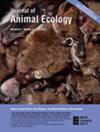Bottom-up and top-down effects combine to drive predator–prey interactions in a forest biodiversity experiment
IF 3.7
1区 环境科学与生态学
Q1 ECOLOGY
引用次数: 0
Abstract

在森林生物多样性实验中,自下而上和自上而下的效应结合起来驱动捕食者-猎物相互作用。
生产者的自下而上效应和捕食者的自上而下效应是众所周知的通过营养相互作用形成群落聚集和生态系统功能的因素。不同功能组成的群落可能会产生不同方向和强度的生态效应,但以往对高度多样化生态系统的研究一直难以在群落水平上可靠地量化这些相互作用。本文利用蜘蛛肠道成分元条形码技术,研究了亚热带树木和蜘蛛的多种多样性成分对猎物多样性和捕食者-猎物相互作用网络结构的影响。研究结果表明,树木群落的自下而上效应和蜘蛛群落的自上而下效应同时驱动着猎物丰富度和蜘蛛猎物网络结构。在不同的捕猎方式下,不同蜘蛛行会的猎物丰富度和网络结构驱动因素存在差异。系统发育和功能上的巨大差异促进了群落的共存,从而增加了猎物的丰富度、一般性、生态位重叠和猎物脆弱性。对于狩猎蜘蛛来说,垂直树结构的复杂性限制了它们的流动性,但通过增加庇护所的可用性,以及随之而来的猎物丰富度和食物宽度的减少,促进了它们的共存。我们的研究强调了在分析通才捕食者的生态效应时,整合多种多样性成分和考虑跨营养水平的功能性状组成的重要性。我们的发现有助于更好地理解在当前环境变化导致生物多样性丧失的情况下,捕食者-猎物相互作用模式是如何改变的。
本文章由计算机程序翻译,如有差异,请以英文原文为准。
求助全文
约1分钟内获得全文
求助全文
来源期刊

Journal of Animal Ecology
环境科学-动物学
CiteScore
9.10
自引率
4.20%
发文量
188
审稿时长
3 months
期刊介绍:
Journal of Animal Ecology publishes the best original research on all aspects of animal ecology, ranging from the molecular to the ecosystem level. These may be field, laboratory and theoretical studies utilising terrestrial, freshwater or marine systems.
 求助内容:
求助内容: 应助结果提醒方式:
应助结果提醒方式:


